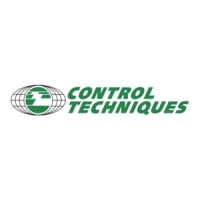Mentor ll User Guide 45
Issue Number: 12 www.controltechniques.com
The factor by which the speed error is multiplied to produce the
correction term.
where f = supply frequency
This term ensures zero speed error during steady state load conditions,
increasing the value increases the rate of recovery after a disturbance.
If the term is made too high, speed tends to oscillate instead of settling
quickly. The optimum setting is the highest value possible before
oscillation starts to occur. Optimum speed loop performance is achieved
by judicious combination of all three gains of the PID algorithm.
The integral term will be clamped if torque mode is selected or if the
Drive is in current limit.
The factor by which the speed error is multiplied to produce the
correction term. There are three possible sources of input to this term
either final speed demand 03.01, speed feedback 03.02, or speed error
03.06. The selector is 03.24. The derivative term is a function of the rate
of change of value of the input.
If the input is the speed error 03.06, output is negative if speed error is
increasing. This has a damping effect.
If the input is the final speed demand 03.01, output is positive when the
final speed demand is increasing. This is called velocity feed forward.
If the input is the speed feedback 03.02, output is negative if speed
feedback is increasing. This also has a damping effect, but dependent
on the changing value of the speed feedback only, not the speed
reference.
Set to 1 to select encoder (pulse tach.) feedback. Set to 0 to select
analog feedback.
Determines the type of analog speed feedback when 03.12 is set to 0.
Set to 1 to select armature voltage feedback. Default setting selects
analog feedback from a tachogenerator (tachometer) or equivalent
external source connected to terminal TB1-09.
The value should be set to correspond with the maximum speed of the
motor and with the number of lines-per-revolution of the encoder (pulse
tach.). To calculate the scale factor:
where:
N = PPR for the encoder (pulse tachometer)
n = max speed of motor in rpm.
Default value is determined on the basis of a 1024-line encoder (pulse
tach.), and a maximum speed of 1750rpm. Maximum frequency for the
encoder is 105kHz.
Defines the maximum voltage permitted to be applied to the armature.
When armature voltage is the selected feedback (03.12 =0and03.13 =
1), the max. armature voltage value is used for scaling the armature
voltage measurement so that speed feedback is full scale at maximum
voltage.
If the speed feedback is derived from an encoder (pulse tach.) or
tachogenerator (tachometer), the armature voltage is continuously
monitored, and the clamp is applied when the voltage exceeds that set in
03.15. This can be used to prevent the voltage rising above a set level.
An automatic scale factor of 1.2 is applied to clamp the armature voltage
feedback to 20% above maximum, to allow for overshoot.
Used only to scale the speed feedback so that the value displayed in
03.03 is actual speed in rpm. The value applied to 03.16 should be the
max. speed in rpm (divided by ten if the maximum speed is >1999rpm;
speed displayed in 03.03 is then rpm 10.)
Thisvalueisusedtocalculatethecompensationfortheresistive
voltage-drop of the armature to improve speed control with varying loads
when the selected speed feedback is the armature voltage.
IR compensation is a positive feedback, and may give rise to instability if
set too high. Furthermore, modern laminated-frame motors have
typically a rising load-speed characteristic which is unsuited to armature
voltage feedback with IR compensation. IR compensation is more suited
to compound-wound motors with a flat (not rising) load-speed
characteristic.
The integral of the speed error is used as the input to IR compensation
rather than current feedback because it is the most smooth of the
variables; in speed control, the value of the speed error integral is the
steady-state value of current demand.
03.10 Speed loop integral gain
RW Uni
ô
0~255
ð
040
03.11 Speed loop derivative gain
RW Uni
ô
0~255
ð
0
03.12 Digital feedback selector
RW Bit
ô
0or1
ð
0 (analog feedback)
03.13
Armature voltage / external analog
feedback selector
RW Bit
ô
0or1
ð
0 (analog feedback)
Factor
6f 03.10()×
256
-------------------------------
=
03.14 Encoder feedback scaling
RW Uni
ô
0~1999
ð
+419
03.15 Maximum armature voltage
RW Uni
ô
0~1000
ð
+600 V
03.16 Maximum speed (scaling rpm)
RW Uni
ô
0~1999
ð
+1750 rpm
03.17 IR Compensation
RW Uni
ô
0~255
ð
000
ScaleFactor
750 10
6
×
Nn×
-------------------------
=
ValueOf03.05
03.08()03.17()×
2048
----------------------------------------------
=

